 W
WBeadwork is the art or craft of attaching beads to one another by stringing them onto a thread or thin wire with a sewing or beading needle or sewing them to cloth. Beads are produced in a diverse range of materials, shapes, and sizes, and vary by the kind of art produced. Most often, beadwork is a form of personal adornment, but it also commonly makes up other artworks.
 W
WAnglo-Saxon glass has been found across England during archaeological excavations of both settlement and cemetery sites. Glass in the Anglo-Saxon period was used in the manufacture of a range of objects including vessels, beads, windows and was even used in jewellery. In the 5th century AD with the Roman departure from Britain, there were also considerable changes in the usage of glass. Excavation of Romano-British sites have revealed plentiful amounts of glass but, in contrast, the amount recovered from 5th century and later Anglo-Saxon sites is minuscule.
 W
WA bail is a component of certain types of jewelry, mostly necklaces, that is used to attach a pendant or stone. The bail is normally placed in the center of the necklace where the pendant hangs.
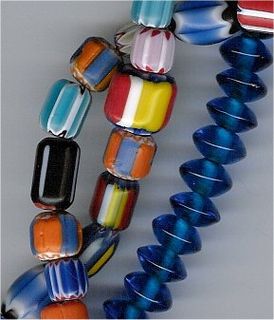 W
WA bead is a small, decorative object that is formed in a variety of shapes and sizes of a material such as stone, bone, shell, glass, plastic, wood or pearl and with a small hole for threading or stringing. Beads range in size from under 1 millimetre (0.039 in) to over 1 centimetre (0.39 in) in diameter.
 W
WBead crochet is a crochet technique that incorporates beads into a crochet fabric. The technique is used to produce decorative effects in women's fashion accessories. The word "crochet" is derived from the French "croche" or "croc" meaning "to hook". Published descriptions of bead crochet date from around 1824 although it was probably common before then. At one time, bead crochet was thought by some people to be appropriate only for rich people.
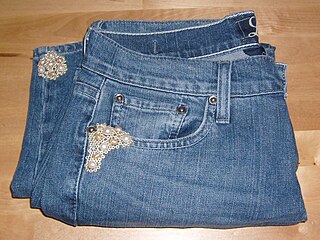 W
WBead embroidery is a type of beadwork that uses a needle and thread to stitch beads to a surface of fabric, suede, or leather.
 W
WBeaded knitting is a type of knitting in which the stitches are decorated with ceramic or glass beads.
 W
WBead stringing is the putting of beads on string.
 W
WLampworking is a type of glasswork in which a torch or lamp is used to melt the glass. Once in a molten state, the glass is formed by blowing and shaping with tools and hand movements. It is also known as flameworking or torchworking, as the modern practice no longer uses oil-fueled lamps. Although lack of a precise definition for lampworking makes it difficult to determine when this technique was first developed, the earliest verifiable lampworked glass is probably a collection of beads thought to date to the fifth century BC. Lampworking became widely practiced in Murano, Italy in the 14th century. As early as the 17th century, itinerant glassworkers demonstrated lampworking to the public. In the mid-19th century lampwork technique was extended to the production of paperweights, primarily in France, where it became a popular art form, still collected today. Lampworking differs from glassblowing in that glassblowing uses a furnace as the primary heat source, although torches are also used.
 W
WBrick Stitch, also known as the Cheyenne Stitch or Comanche Stitch, is a bead weaving stitch in which individual beads are stacked horizontally in the same pattern as bricks are stacked in a wall.
 W
WChevron beads are special glass beads; the first specimens of this type were created by glass bead makers in Venice and Murano, Italy, toward the end of the 14th century. They may also be referred to as rosetta, or star beads. The term rosetta first appeared in the inventory of the Barovier Glass works in Murano, in 1496, in context with beads as well as with other glass objects.
 W
WThe Chief's bead, named "ti-a, co-mo-shack" by North American Natives, are blue glass trade beads used during the late 18th century and early 19th century up and down the West coast of North America and the Columbia River Basin. The Chief's beads were sought by Native American tribes in preference over beads of other colors because they were blue. An indication of the importance of the blue Chief's bead was that after the Lewis and Clark Expedition returned from their 1803–1806 expedition of discovery to find a route from Missouri to the Pacific Ocean, the leader Captain Meriwether Lewis stated that if he were to return, he would make the blue bead half to two-thirds of his trading goods.
 W
WDzi bead is a type of stone bead of uncertain origin worn as part of a necklace and sometimes as a bracelet. In several Central Asian cultures, including that of Tibet, the bead is considered to provide positive spiritual benefit. These beads are generally prized as protective amulets and are sometimes ground into a powder to be used in traditional Tibetan medicine. Beads subject to this process have small "dig marks" where a portion of the bead has been scraped or ground away to be included in the medicine. Some dzi exhibit grinding and polishing of one or both ends, again the result of reduction for use in traditional Tibetan medicine or, in some cases, due to the bead's use as a burnishing tool in the application of gold leaf to thanka paintings or gilt bronze statuary.
 W
WFaturan, in Middle Eastern beadwork, is a material used to make beads, notably in the making of komboloi and misbaha.
 W
WGlass beadmaking is among the oldest human arts, with the oldest known beads dating over 3,000 years. Glass beads have been dated back to at least Roman times. Perhaps the earliest glass-like beads were Egyptian faience beads, a form of clay bead with a self-forming vitreous coating. Glass beads are significant in archaeology because the presence of glass beads often indicate that there was trade and that the beadmaking technology was being spread. In addition, the composition of the glass beads could be analyzed and help archaeologists understand the sources of the beads.
 W
WHebron Glass refers to glass produced in Hebron as part of a flourishing art industry established in the city during Roman rule in Palestine. The Old City of Hebron still contains a quarter named the "Glass-Blower Quarter" and Hebron glass continues to serve as a tourist attraction for the city.
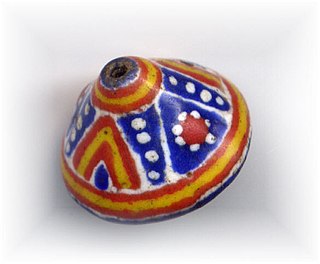 W
WKiffa beads are rare powder glass beads. They are named after the Mauritanian city of Kiffa, where French ethnologist R.Mauny documented them first in 1949.
 W
WWorry beads or kombolói, kompoloi is a string of beads manipulated with one or two hands and used to pass time in Greek and Cypriot culture. Unlike the similar prayer beads used in many religious traditions, worry beads have no religious or ceremonial purpose.
 W
WLampworking is a type of glasswork in which a torch or lamp is used to melt the glass. Once in a molten state, the glass is formed by blowing and shaping with tools and hand movements. It is also known as flameworking or torchworking, as the modern practice no longer uses oil-fueled lamps. Although lack of a precise definition for lampworking makes it difficult to determine when this technique was first developed, the earliest verifiable lampworked glass is probably a collection of beads thought to date to the fifth century BC. Lampworking became widely practiced in Murano, Italy in the 14th century. As early as the 17th century, itinerant glassworkers demonstrated lampworking to the public. In the mid-19th century lampwork technique was extended to the production of paperweights, primarily in France, where it became a popular art form, still collected today. Lampworking differs from glassblowing in that glassblowing uses a furnace as the primary heat source, although torches are also used.
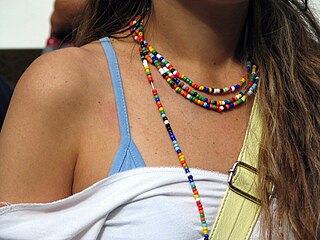 W
WLove beads are one of the traditional accessories of hippies. They consist of one or more long strings of beads, frequently handmade, worn around the neck by both sexes. The love bead trend probably evolved from the hippie fascination with non-Western cultures, such as those of Africa, India, and Native America, which make common use of similar beads.
 W
WMagatama are curved, comma-shaped beads that appeared in prehistoric Japan from the Final Jōmon period through the Kofun period, approximately 1000 BCE to the 6th century CE. The beads, also described as "jewels", were made of primitive stone and earthen materials in the early period, but by the end of the Kofun period were made almost exclusively of jade. Magatama originally served as decorative jewelry, but by the end of the Kofun period functioned as ceremonial and religious objects. Archaeological evidence suggests that magatama were produced in specific areas of Japan and were widely dispersed throughout the Japanese archipelago via trade routes.
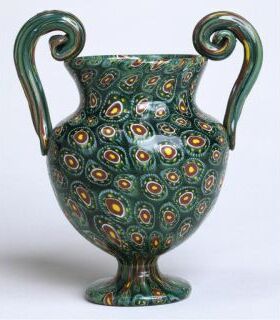 W
WMillefiori is a glasswork technique which produces distinctive decorative patterns on glassware. The term millefiori is a combination of the Italian words "mille" (thousand) and "fiori" (flowers). Apsley Pellatt in his book Curiosities of Glass Making was the first to use the term "millefiori", which appeared in the Oxford English Dictionary in 1849; prior to that, the beads were called mosaic beads. While the use of this technique long precedes the term "millefiori", it is now most frequently associated with Venetian glassware.
 W
WThe term mutisalah refers to heirloom beads in the Lesser Sunda Islands of Timor, Flores, Sumba and Savu. Mutisalah are also found in the Philippines and Borneo. Mutisalah were originally Indo-Pacific beads of orange and orange-red color. The earliest of these beads came from Southern India and have been dated as early as 200 BC. Their manufacture spread to other centers.
 W
WPeranakan beaded slippers, also known as Kasut Manik, literally meaning "beaded shoes", is a type of shoe that dates back to the early twentieth century Malaya. It refers to beaded slippers worn by a nyonya to complete her Sarong Kebaya outfit, together with chained brooches (kerosang) and a silver belt. The slippers are made of Peranakan cut beads, which are treasured as these beads are no longer available. Vintage Kasut Maniks are intricate and finely stitched, a testimony to the fine workmanship of yesteryears. The intricacy and fine workmanship of a pair of the beaded slipper is also a hallmark of highly accomplished Peranakan women, also known as Nyonya, whose skills in embroidery and beadwork are highly valued.
 W
WPeranakan cut beads are faceted glass beads used by the Peranakan women to make Peranakan beaded slippers and other Peranakan artifacts like wedding veils, handbags, belts, tapestries and pouches.
 W
WPowder glass beads are a type of necklace ornamentation. The earliest such beads were discovered during archaeological excavations at Mapungubwe in South Africa, and dated to between 970-1000 CE. Manufacturing of the powder glass beads is now concentrated in West Africa, particularly in the Ghana area. The origins of beadmaking in Ghana are unknown, but the great majority of powder glass beads produced today is made by Ashanti and Krobo craftsmen and women. Krobo bead making has been documented to date from as early as the 1920s but despite limited archaeological evidence, it is believed that Ghanaian powder glass bead making dates further back. Bead making in Ghana was first documented by John Barbot in 1746. Beads still play important roles in Krobo society, be it in rituals of birth, coming of age, marriage, or death.
 W
WSeed beads or rocailles are uniformly shaped, spheroidal beads ranging in size from under a millimeter to several millimeters. Seed bead is also a generic term for any small bead. Usually rounded in shape, seed beads are most commonly used for loom and off-loom bead weaving. They may be used for simple stringing, or as spacers between other beads in jewelry.
 W
WA sequin is a small, disk-shaped, shiny bead.
 W
WTrade beads are beads that were used as a medium of barter within and amongst communities. They are considered to be one of the earliest forms of trade between members of the human race. It has also been surmised that bead trading was one of the reasons why humans developed language.